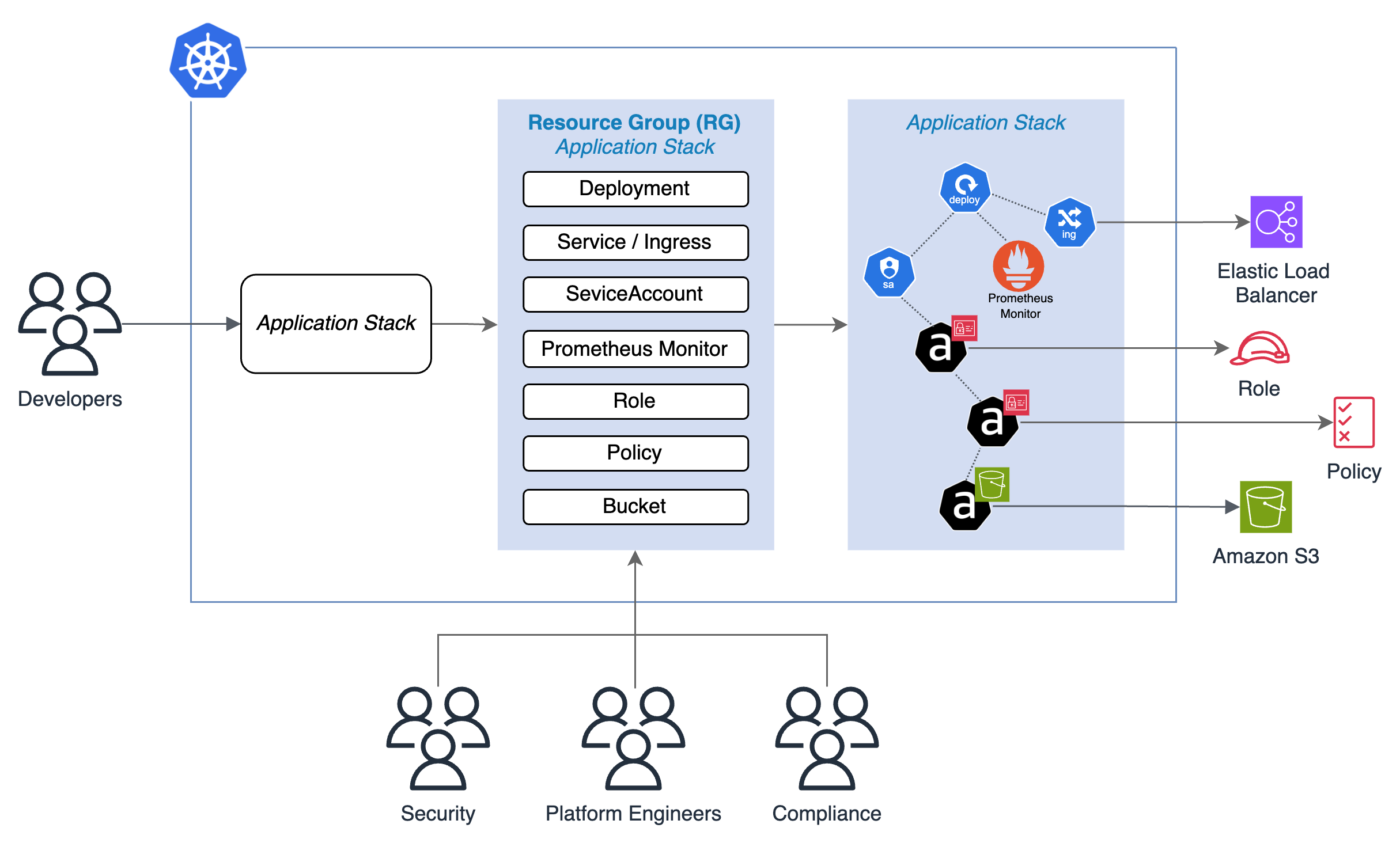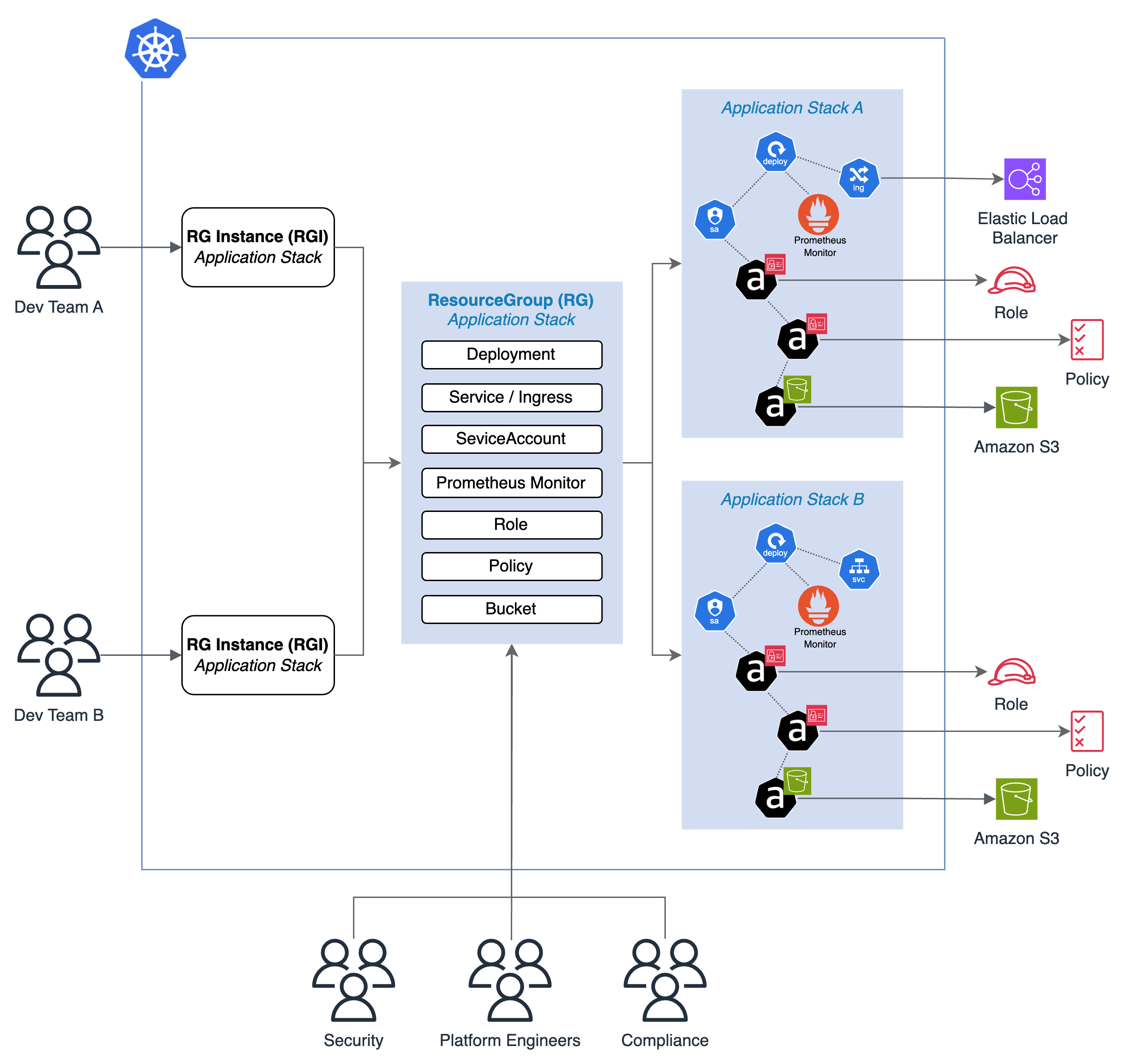What is kro?
kro (Kube Resource Orchestrator) is an open-source, Kubernetes-native project that allows you to define custom Kubernetes APIs using simple and straightforward configuration. With kro, you can easily configure new custom APIs that create a group of Kubernetes objects and the logical operations between them. kro uses CEL (Common Expression Language), the same language used by Kubernetes webhooks, for logical operations. Using CEL expressions, you can pass values from one object to another and incorporate conditionals into your custom API definitions. Based on the CEL expressions, kro automatically calculates the order in which objects should be created. You can define default values for fields in the API specification, so end users can invoke these custom APIs to create grouped resources with minimal configuration.
Example: Complete ResourceGraphDefinition
How does kro work?
Developer interface
When the end user applies a YAML spec to the cluster using the Custom API, the API creates a set of resources within the cluster. These resources can include both native Kubernetes resources and any Custom Resource Definitions (CRDs) installed in the cluster. Some of these resources may create additional resources outside of your cluster.
As depicted in the following diagram, the Developers call the Custom API, which creates resources such as the Deployment, Ingress, ServiceAccount, Prometheus Monitor, IAM Role, IAM Policy, and Amazon S3 Bucket. This allows Developers to manage and deploy their applications in a standardized way.
 Figure 1: End user interface - Custom API
Figure 1: End user interface - Custom API
ResourceGraphDefinition
When you install Kro in your cluster, it installs a Custom Resource Definition (CRD) called ResourceGraphDefinition (RGD). The Platform, Security, and Compliance teams can collaborate to create custom APIs by defining Custom Resources for the ResourceGraphDefinition CRD.
In the depicted example, the Platform Team has created an RGD with arbitrary name "Application Stack" that encapsulates the necessary resources, along with any additional logic, abstractions, and security best practices. When the RGD is applied to the cluster, a new API of kind ApplicationStack is created and available for the Developer to interact with. The Developers no longer need to directly manage the underlying infrastructure complexities, as the custom API handles the deployment and configuration of the required resources.
 Figure 2: ResourceGraphDefinition (RGD) - Platform Team Interface
Figure 2: ResourceGraphDefinition (RGD) - Platform Team Interface
ResourceGraphDefinition Instance
Developer teams can create multiple instances of the Application Stack, each tailored to their specific requirements. As shown, Dev Team A and Dev Team B have both instantiated their own Application Stacks. While the underlying resources are similar, Dev Team A has chosen to expose their service externally using the Ingress option, while Dev Team B has opted to keep their service internal to the cluster. This flexibility allows each development team to customize their application stack based on their specific requirements.
 Figure 3: ResourceGraphDefinition Instance
Figure 3: ResourceGraphDefinition Instance
Why kro?
Manage any group of resources as one unit
Using kro, the Platform Team can enable Developer teams to quickly deploy and manage applications and their dependencies as one unit, handling the entire lifecycle from deployment to maintenance. The new APIs integrate seamlessly with developers' existing CD tools, preserving familiar processes and interfaces to simplify adoption.
Collaborate
Transform Kubernetes into your unified platform configuration framework using kro. Platform, Compliance, and Security teams work together to develop APIs that standardize configurations, making it easier for Developer teams to adopt secure, compliant practices. This collaboration lets you build your organizational standards directly into the APIs, ensuring every application deployment aligns with security and compliance requirements without adding complexity for developers.
Standardize
By creating unified APIs, you can define and enforce best practices across all environments, ensuring every application meets organizational requirements and achieving consistency across deployment environments.
Community
We welcome questions, suggestions, and contributions from the community! To get involved, check out our contributing guide. For bugs or feature requests, feel free to submit an issue. You're also invited to join our community.